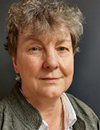Co-Located Conference AgendasLab-on-a-Chip and Microfluidics Europe 2022 | Organoids and Organs-on-Chips Europe 2022 | Point-of-Care, Biosensors and Mobile Diagnostics Europe 2022 | 

Tuesday, 21 June 2022 |
Please Refer to the Lab-on-a-Chip Agenda for Details of Programming on Tuesday Morning, 21 June 2022 |
| | 13:00 | Networking Lunch in the Exhibit Hall with Exhibitors and Conference Sponsors + Poster Viewing | |
Session Title: Technologies and Themes in the Organs-on-Chips Space 2022 |
| | 15:00 |  | Keynote Presentation Microfluidics as an Enabling Technology For Monitoring Liver Tissue Behaviour
Elisabeth Verpoorte, Chair of Analytical Chemistry and Pharmaceutical Analysis, University of Groningen, Netherlands
Microfluidics is in many ways a mature technology when it comes to culturing cells and tissue for physiological studies of healthy and diseased organ models in vitro. The idea that a researcher can manipulate the cellular microenvironment more effectively in small microchannels than larger containers has been well established in the organ-on-a-chip concept. The fluid handling control that is inherent to microfluidics has also been exploited to develop dynamic experiments in which conditions are changed precisely over time. Moreover, flow can be managed in such a way that medium can be continuously delivered to built-in sensors and/or external analysis systems, enabling quantitative monitoring of physiological processes. In this presentation, I will talk about some recent work we have done together with various partners in which we exploit microfluidics to achieve new analytical approaches to more comprehensively understand the behavior of precision-cut liver slices in vitro. |
| 15:30 |  | Keynote Presentation Advancing Preclinical in vitro Pulmonary Platforms For Ventilation and Inhalation Assays
Josué Sznitman, Associate Professor, Technion – Israel Institute of Technology, Israel
Over the past years, advanced in vitro pulmonary platforms have witnessed exciting developments that are pushing beyond traditional preclinical cell culture methods. Here, we discuss ongoing efforts in bridging the gap between in vivo and in vitro interfaces and identify some of the bioengineering challenges that lie ahead in delivering new generations of human-relevant preclinical in vitro pulmonary platforms. Undeniably, there still remains a recognized trade-off between the physiological and biological complexity of in vitro lung models and exemplify various models developed in our group. With growing interest in aerosol transmission and infection of respiratory viruses within a host, most notably the SARS-CoV-2 virus amidst the global COVID-19 pandemic, the importance of crosstalk between the different lung regions (i.e. extra-thoracic, conductive and respiratory), with distinct cellular makeups and physiology, are acknowledged to play an important role in the progression of the disease from the initial onset of infection. We showcase a number of examples from our group including the first multi-compartment human airway-on-chip platform to serve as a preclinical in vitro benchmark underlining regional lung crosstalk for viral infection pathways. |
| 16:00 | Use of a Novel 3D Islet Spheroid Platform to Model and Understand Auto- and Allo-Immune Attacks on Human Islets
Matthias von Herrath, Vice President and Senior Medical Officer, Novo Nordisk, Professor, La Jolla Institute, United States of America
Over the past years we have engineered an in vitro system that can replicate key aspects we have seen in human type 1 diabetes pathogenesis, such as upregulation of MHC class I and II on islets, attack by cytotoxic T cells as well as mixed allo- and auto-immune attacks. We will demonstrate the system's utility, notably that the readout is very sensitive in respect to beta cell function (glucose induced insulin secretion), rather than cell death. This system can be helpful in understanding which factors and pathways are key for beta cell destruction and their relative importance. It is also useful in evaluating the ability of beta cell targeted therapies to lower the immune attack. | 16:30 | Human Vascular Microphysiological Systems for Disease Modeling
George Truskey, R. Eugene and Susie E. Goodson Professor of Biomedical Engineering, Duke University, United States of America
| 17:00 | Pancreas Cancer Modeling Enables Precision Medicine
Hervé Tiriac, Assistant Researcher, University of California-San Diego, United States of America
Ex-vivo modeling of pancreatic ductal adenocarcinoma enables the study of patient-specific responses and facilitates study of drug resistance. | 17:30 | Heart-on-a-Chip System with Polymeric Nanofiber Mats as a New Approach for Mimicking Heart Tissue Microphysiology
Elzbieta Jastrzebska, Professor and Chair of Medical Biotechnology, Warsaw University of Technology, Poland
Heart-on-a-chip system made of polycarbonate-poly(dimethylsiloxane)-polycarbonate (PC-PDMS-PC) layers, integrated with polymeric nanofibers, was developed to study cardiac cell function and mimicking a state of heart disease. | 18:00 |  Networking Reception with Beer and Wine: Network with Colleagues and Engage with Exhibitors and Conference Sponsors. French Wine Tasting Sponsored by Kloé Networking Reception with Beer and Wine: Network with Colleagues and Engage with Exhibitors and Conference Sponsors. French Wine Tasting Sponsored by Kloé
Paul Coudray, CEO, Kloé SAS
| 19:00 | Close of Programming on Day 1 of the Conference |
Wednesday, 22 June 202208:00 | Morning Coffee, Tea and Networking in the Exhibit Hall | |
Session Title: Organoids and Organ-on-a-Chip 2022 - Continued |
| | 09:00 |  The Benefits of Long-Term Live-Cell Imaging of Organoids and Organ-on-Chips The Benefits of Long-Term Live-Cell Imaging of Organoids and Organ-on-Chips
Nathalie van de Laar, Application Scientist, CytoSMART Technologies B.V.
Different in-incubator live-cell imaging devices can be used for monitoring organoids and organ-on-chips over time. This presentation showcases different methods of monitoring and imaging of organoids and organ-on-chips and will highlight the benefits for specific applications.
| 09:30 |  | Keynote Presentation Organ-on-Chip Models For Medical Applications
Séverine Le Gac, Professor, Applied Microfluidics for Bioengineering Research, MESA+ Institute for Nanotechnology, University of Twente, Netherlands
Organ-on-chip (OoC) platforms are currently considered as the next-generation in vitro models for various fields of applications such as drug and toxicity screening, disease modeling, tissue regeneration, metabolic studies, etc. Key advantages offered by these models compared to standard alternatives like 3D cell culture, are, for instance: (i) the possibility to accurately control the cellular microenvironment; (ii) to implement dynamic culture conditions in a microfluidic format; (iii) to emulate the architecture and/or the function of targeted organs by combining specific microfabricated structures with cells; and (iv) to stimulate the cells in the device, e.g., chemically, mechanically, and electrically, with an excellent spatiotemporal control.
In my presentation I will present current work from the group in the field of cancer research, and the implementation of biomechanical cues in OoCs, notably for the development of a cartilage model. |
| 10:00 |  | Keynote Presentation ENGINEERING A JOINT-ON-CHIP FOR EVALUATION OF NEW DRUGS FOR TREATMENT OF DEGENERATIVE JOINT DISEASES
Marcel Karperien, Head Department of Developmental BioEngineering, TechMed Centre, University of Twente, Netherlands
Degenerative joint diseases such as osteoarthritis are a major and rising health care problem which still cannot be effectively treated. Consequently there is still a large unmet need for disease modifying treatments, with many attempts failed at phase 2 and 3 clinical trials due to lack of efficacy in recent years. This is in part due to the lack of translational power of frequently used animal models. To address this issue we have engineered the first prototypes of a cartilage-on-chip and a synovial membrane-on-chip which can be combined in a multi-organ on-chip device; the Joint-on-Chip (JoC). The cartilage-on-chip model comprises a mechanical actuation unit, a cell-hydrogel chamber, which can be filled with chondrocyte-laden hydrogel, and a perfusion channel. Uniquely, the cell-hydrogel chamber can be exposed to mechanical loading emulating the rolling motion of the moving knee joint. For this the mechanical stimulation unit consisted of 3 units which can be independently actuated. The synovial membrane-on-chip comprises two compartments separated by a thin non-porous membrane. The upper chamber is used for culturing synovial fibroblasts and macrophages constituting the synovial lining of the intima, while the bottom chamber is used for culturing endothelial cells emulating the subintima. In our cartilage-on-chip model we showed that emulating the rolling motion of the joint resulted in the deposition of more cartilaginous matrix composed of glycosaminoglycans and collagen 2 and 6. It also induced the formation of a pericellular matrix. Matrix formation was much more abundant than in the devices exposed to compression only and to static culture in which there was virtually no matrix formation. This suggests that a combination of compression and shear stress such as uniquely seen during a rolling motion is beneficial for cartilage formation. We furthermore showed that in our device iPS cells could be differentiated into chondrocytes and that mechanical loading increased differentiation as evidenced by improved cartilage matrix deposition and marker expression. In the synovial membrane-on-chip we showed that the presence of endothelial cells is required for macrophage integration into the synoviocyte layer and the subsequent polarization into the M2 phenotype emulating the intima in healthy conditions. Challenging this intima with proinflammatory cytokines evoked a classical inflammatory response with increased mRNA expression of matrix degrading enzymes and pro-inflammatory cytokines and chemokines and upregulation of markers typically present in rheumatoid arthritis. In conclusion, we have successfully engineered cartilage and synovial membrane on-chip models which will allow us to emulate healthy and diseased conditions in a JoC. Presently we are using this model for studying pathophysiological mechanisms of disease and its application in drug development programs. |
| 10:30 | Mid-Morning Coffee and Tea Break and Networking in the Exhibit Hall | 11:00 |  Advancing Screening of Organoids: Combined Acquisition and Analysis Solutions Advancing Screening of Organoids: Combined Acquisition and Analysis Solutions
Przemek Fleszar, Senior Application Scientist – Imaging, Molecular Devices
Organoids offer the potential for enhanced modelling of human tissues. Derived from stem cells, organoids can be differentiated into a wide range of tissue types including liver, lung, brain, kidney, stomach, and intestine. Since these 3D microtissues mimic in vivo organs, they can provide researchers with greater insight into the mechanisms of human development and disease as well as offer a more predictive tool during the drug discovery process. However, the complexity of performing 3D assays remains a hurdle for widespread adoption in a compound screening context. Automated confocal imaging systems, combined with powerful 3D image analysis software and – more recently – machine learning, can empower researchers to streamline their workflow, increase throughput and obtain optimal results. Such solutions can also be integrated into larger automated workflows, offering a complete end-to-end solution to streamline and scale organoid interrogation.
| 11:30 | Midbrain Organoids for Parkinson’s Disease Modeling
Cláudia Saraiva, Post-Doctoral Researcher, University of Luxembourg, Luxembourg
Parkinson’s disease (PD) is the second most prevalent disorder worldwide and its incidence is rising. Nevertheless, few advances in PD treatment have been observed. Therefore, understanding of PD associated mechanisms using novel complex and translatable models is timely. In our lab, we developed 3D cultures that resemble the human midbrain (midbrain organoids, MOs) through guided differentiation of induced pluripotent stem cells (iPSCs). The MOs are a complex system in terms of cellular composition and structural organization. Using PD patient-derived MOs we demonstrate that not only they resemble the midbrain organization but they also recapitulate key features of the PD pathology, such as dopaminergic neuron differentiation. Using this technology, we are currently investigating the role of the recently described Miro1 protein in dopaminergic differentiation in PD. Using high content imaging and western blotting we observed that a gain-of-function in Miro1 results in lower levels of dopaminergic neuros. Also Miro1-mutant MOs show a mitochondrial impairment when compared with healthy controls. Altogether, this work shows the importance of Miro1 in the pathology of Parkinson, and shed light into a possible novel and convergent pathway in PD. | 12:00 | A Review of Biomaterials and Scaffold Fabrication for Organ-on-a-Chip (OOAC) Systems
Luana Osorio, Doctoral Student, Brunel University London, United Kingdom
This presentation focus on different materials and manufacturing techniques used to produce scaffolding membranes for Organ-on-a-Chip devices that aim to recapitulate in vivo tissues mechanical/chemical behavior. | 12:30 | 3D Multicellular Tumor Spheroids to Study Intra-Tumor Heterogeneity and Cell Communication In Colorectal Cancer
Wenjin Xiao, Postdoctoral Fellow, Centre de Recherche des Cordeliers, Université Paris Cité, France
The major underlying cause for colorectal cancer (CRC) high mortality rate relies on its drug resistance, to which intra-tumor heterogeneity (ITH) contributes extensively. However, the impact of ITH on CRC evolution and drug resistance remains underexplored. Multicellular tumour spheroids (MCTSs) have been highlighted as pertinent in vitro cancer models, since they are able to more accurately mimic both the 3D structure of malignant tissue and the cancer microenvironment compared to the traditional 2D format. Here, we describe a 3D spheroid model that could mimick the ITH of CRC to study the effect of heterogeneous inter-cellular communication. These MCTSs were composed of CRC cell lines with distinct molecular subtypes, which were capable to grow into a physiological relevance size in a 4-day culture. We observed the specific spatial distribution of each cell population within the spheroids, in line with the observations in tumours. Interestingly, co-cultures did not alter the cell growth in the MCTSs, but significantly sustained the cellular survival in response to a front-line chemotherapeutic drug, 5-Fluorouracil (5-FU). This phenomenon can be supported by the cell secretome, which showed not only remarkable protective effect against 5-FU treatments, but also sustained cell migration and invasion capacity, suggesting that direct cell-cell interaction is not key in this cell communication. Overall, our MCTS model shows a possibility to mimic ITH and to study the therapy-induced cell interplay in vitro, which could potentially stimulate patient CRC progression and in this manner reduce chemotherapy efficacy. | 13:00 | Networking Lunch in the Exhibit Hall with Exhibitors and Conference Sponsors + Poster Viewing | |
Please Refer to the POC Diagnostics Agenda for Details of Programming on Wednesday Afternoon, 22 June 2022 |
| |
|


 Add to Calendar ▼2022-06-21 00:00:002022-06-22 00:00:00Europe/LondonOrganoids and Organs-on-Chips Europe 2022Organoids and Organs-on-Chips Europe 2022 in Rotterdam, The NetherlandsRotterdam, The NetherlandsSELECTBIOenquiries@selectbiosciences.com
Add to Calendar ▼2022-06-21 00:00:002022-06-22 00:00:00Europe/LondonOrganoids and Organs-on-Chips Europe 2022Organoids and Organs-on-Chips Europe 2022 in Rotterdam, The NetherlandsRotterdam, The NetherlandsSELECTBIOenquiries@selectbiosciences.com